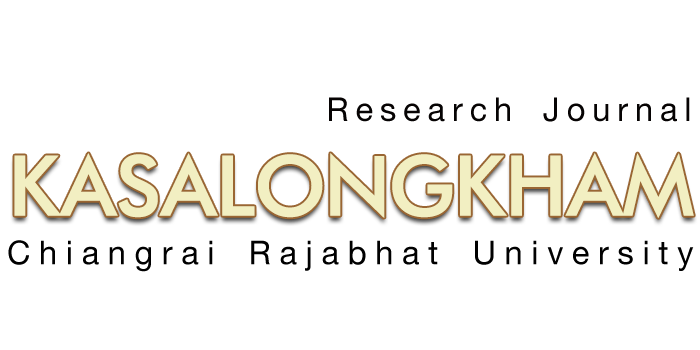The Meta-Analysis of The Teaching Models Efficiency Affecting The Analytic Thinking of the Learners.
Keywords:
The Meta-Analysis, Teaching Models, EfficiencyAbstract
The purposes of this research were to analyze the experimental and developmental researches on the teaching models to develop the learners’ analytical thinking. The specific objectives were to analyze the effect size of the teaching models affecting the learners’ analytical thinking and to compare the efficiency of the teaching models affecting the learners’ analytical thinking, to study the correlation between the teaching models to develop the learners’ analytical thinking and the class level and the subject, to study the differences of the efficiency of the teaching models affecting the learners’ analytical thinking from the characteristics of the research and to analyze the direct and indirect effect of the research characteristics towards the effect size with the causal factor analysis by using LISREL. The sample were 69 researches from the population of 88 researches of the graduates published on line in ThaiLIS database between the year 2003 to 2009. Two groups of independent variables were 44 variables of teaching models to develop the learners’ analytical thinking and 19 variables of the research characteristics. The dependent variable was the effect size. The research instruments drawn for this study were 1) the research selection form, 2) the research quality evaluation form, 3) the research characteristics record. The data were systematically analyzed by using the descriptive statistic, the meta analysis of the effect size of Glass and team and estimated effect size by using the statistic without the measurement error of Hedges and Olkin, One-way ANOVA, Two way ANOVA, Multiple Regression and Analyzed the casual by using LISREL. The results of the study were found as follows;
- There were 44 values of the effect size of the teaching models affecting the analytical thinking of the students. The effect size was between -.48 to 1.93. There were 41 values in the high level, 2 values in the low level and 1 value in the minus value.
- 44 teaching models were synthesizes in this study. There were 41 methods had the high efficiency for the learners’ analytical thinking. 2 methods had the low efficiency and one method did not have the efficiency. The highest effective teaching model was the 7-E Learning Cycle and Instruction Model.
The differences of the efficiency of the development of the learners’ analytical thinking of 3 groups of teaching models consisted of the international teaching models group, the teaching models which Thai graduates created or integrated by applying from the international teaching models, and the teaching models created or developed by Thai graduates.
- The correlation between the teaching models to develop the learners’ analytical thinking and the class level and the subject appeared that there was no statistical significance on the direct and total effect towards the teaching models efficiency.
- There was the difference between the mean of the effect size ( d ) and the class level of the sample group in the kindergarten to grade three, Mathayom 1-3 and mathayom 4-6 which was higher than the vocational and the higher vocational certificate level. The mean of the effect size using t-test was higher than using ANOVA and MANCOVA. The means of researches which passed the criteria and failed were higher than the mean of the researches which was considered as the good ones. The result from the Dummy variable of the research characteristics of all 64 variables was 54.70 (adjusted R2 = .547)
- The direct and indirect effect of the research characteristics towards the effect size was tested by the test of the correlation between the model based on the theory created by the researcher and the empirical data using LISREL, it appeared that the model was correlated.
References
ฉัตรศิริ ปิยะพิมลสิทธิ์. การใช้ SPSS เพื่อการวิเคราะห์ข้อมูล. สงขลา : ภาควิชาการประเมินผลและวิจัย
คณะศึกษาศาสตร์ มหาวิทยาลัยทักษิณ, 2548.
ชูศรี วงศ์รัตนะ และ องอาจ นัยพัฒน์. แบบแผนการวิจัยเชิงทดลองและสถิติวิเคราะห์ : แนวคิด
พื้นฐานและวิธีการ = Experimetal Research Desing and Statistics : Basic concept
and Methods. กรุงเทพมหานคร : จุฬาลงกรณ์มหาวิทยาลัย, 2551.
ทิศนา แขมมณี. . ศาสตร์การสอน : องค์ความรู้เพื่อการจัดกระบวนการเรียนรู้ที่มีประสิทธิภาพ.
พิมพ์ครั้งที่ 4. กรุงเทพมหานคร : จุฬาลงกรณ์มหาวิทยาลัย, 2548.
นงลักษณ์ วิรัชชัย. การวิเคราะห์อภิมาน. กรุงเทพมหานคร : จุฬาลงกรณ์มหาวิทยาลัย, 2542.
นิตยา เหมือดไธสง. การส่งอิทธิพลผ่านตัวกลางเชิงสาเหตุของปัจจัยด้านนักเรียน ด้านครู ด้านโรงเรียนไปยัง
ผลสัมฤทธิ์ทางการเรียนคณิตศาสตร์ : การวิเคราะห์อภิมาน. วิทยานิพนธ์ ค.ม. (วิจัยการศึกษา) กรุงเทพมหานคร : จุฬาลงกรณ์มหาวิทยาลัย, 2543.
เบญจมาศ เทพบุตรดี. การเปรียบเทียบผลสัมฤทธิ์ทางการเรียน ความสามารถในการคิดวิเคราะห์และ
ความสามารถในการให้เหตุผลทางคณิตศาสตร์ของนักเรียนชั้นประถมศึกษาปีที่ 6 ระหว่างการจัดการ
เรียนรู้โดยใช้ปัญหาเป็นฐาน (PBL.) และการจัดการเรียนรู้แบบปกติ เรื่อง การบวก ลบ คูณ หาร ทศนิยม. วิทยานิพนธ์ กศ.ม. (หลักสูตรและการสอน) มหาสารคาม : มหาวิทยาลัยมหาสารคาม, 2550.
ปุระชัย เปี่ยมสมบูรณ์ และ สมชาติ สว่างเนตร. การวิเคราะห์เส้นโยงด้วยลิสเรล : สถิติสำหรับ
นักวิจัยทางวิทยาศาสตร์สังคมและพฤติกรรม. กรุงเทพมหานคร : สถาบันบัณฑิต
พัฒนบริหารศาสตร์, 2535.
ปิยะฉัตร ฉ่ำชื่น. การวิเคราะห์อภิมานงานวิจัยปัจจัยที่เกี่ยวข้องกับความพึงพอใจในงานพยาบาล.
วิทยานิพนธ์ พย.ม. (การบริหารการพยาบาล) กรุงเทพมหานคร : จุฬาลงกรณ์มหาวิทยาลัย, 2547.
วรรณี อริยะสินสมบูรณ์. การสังเคราะห์งานวิจัยในสาขาจิตวิทยาการศึกษา : การวิเคราะห์อภิมาน.
วิทยานิพนธ์ปริญญาครุศาตรดุษฎีบัณฑิต สาขาจิตวิทยาการศึกษา กรุงเทพมหานคร :
จุฬาลงกรณ์มหาวิทยาลัย, 2544.
วสันต์ ทองไทย. การออกแบบการวิจัย. (ออนไลน์). แหล่งที่มา : http:www.bpcd.net/new_subject/. 2551.
วัยญา ยิ้มยวน. การวิเคราะห์อภิมานปัจจัยที่มีความสัมพันธ์กับการคิดวิจารณญาณ. วิทยานิพนธ์ครุศาสตร
มหาบัณฑิต สาขาวิจัยการศึกษา กรุงเทพมหานคร : จุฬาลงกรณ์มหาวิทยาลัย, 2547.
ศิริยุภา พูลสุวรรณ. การศึกษาประสิทธิภาพของสื่อการสอนโดยวิธีการวิเคราะห์อภิมาน. ปริญญานิพนธ์
การศึกษาดุษฎีบัณฑิต สาขาวิจัยและประเมินผลการศึกษา กรุงเทพฯ : มหาวิทยาลัยศรีนครินทร
วิโรฒ, 2530.
สรายุทธ์ เศรษฐขจร. การศึกษาปัจจัยที่สัมพันธ์กับผลสัมฤทธิ์ทางการเรียนของนักเรียนระดับมัธยมศึกษา
โดยการวิเคราะห์อภิมาน. วิทยานิพนธ์ กศ.ด. (การบริหารการศึกษา) กรุงเทพมหานคร :
มหาวิทยาลัยศรีนครินทรวิโรฒ, 2539.
อิทธิฤทธิ์ พงษ์ปิยะรัตน์. อิทธิพลของปัจจัยด้านนักเรีน ครู และโรงเรียนที่ส่งผลต่อผลสัมฤทธิ์ทางการเรียน
คณิตศาสตร์ : การวิเคราะห์ด้วยโมเดลเชิงเส้นตรงระดับลดหลั่น. วิทยานิพนธ์ ค.ม.(วิจัยการศึกษา)
กรุงเทพมหานคร : จุฬาลงกรณ์มหาวิทยาลัย, 2542.
อุทุมพร (ทองอุไทย) จามรมาน. การสังเคราะห์งานวิจัย : เชิงปริมาณ (Research Synthesis : A Quantitative
Approach) เน้นวิธีวิเคราะห์เมตต้า (A Meta Analysis). กรุงเทพมหานคร : ฟันนี่พับลิชชิ่ง, 2531.
Cohen, J. Statistical power analysis for the behavioral sciences (2nd ed.).Hillsdale, NJ: Lawrence Earlbaum
Associates (ออนไลน์) แหล่งที่มา : http://books.google.com/,1988.
Gene V. Glass, Barry McGaw, and Mary Lee Smith. META-ANALYSIS IN SOCIAL RESEARCH.
2nd ed. Beverly Hills London : Sage Publications, 1982.


 e-ISSN:
e-ISSN: 

